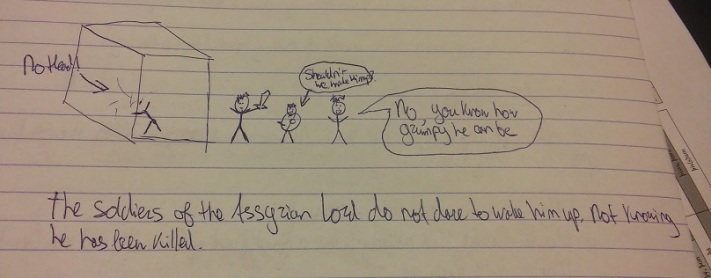For a bonus question on one of my Old English literature exams, my students used their artistic talents to draw scenes from the Old English poem Judith. Together, these doodles cover almost the entire poem and document how well (or how badly) my students remembered the poem.

Drawings have long since been used for the purpose of teaching (for an example from the Anglo-Saxon period see Teaching the Passion to the Anglo-Saxons: An early medieval comic strip in the St Augustine Gospels). On occasion, I use my own drawings to spice up my lectures (such as my Anglo-Saxon Anecdotes) or to explain complicated bits of Anglo-Saxon literature (e.g., The Freoðuwebbe and the Freswael: A Comic Strip Reconstruction of the Finnsburg Fragment and Episode). In recent years, I have decided to turn the tables on my students and, for a bonus point (worth 1% of the exam grade), I have them draw scenes from Old English poems, discussed in class.
While the exercise was intended as a bit of a gag, their doodles actually allowed me to see which events from the poem had captured their interest; how they (mis)remembered certain passages and which scenes, apparently, made no impact on them at all. In previous blog posts, I shared their renditions of The Battle of Maldon (The Battle of Maldon: A Student Doodle Edition) and the fight between Beowulf and the dragon (Beowulf vs the Dragon: A Student Doodle Edition) . Below follows a selection of my students’ drawings that deal with the Old English poem Judith, along with some commentary.
i) It all started with a party…

The Old English Judith is an Anglo-Saxon verse adaptation of the Old Testament book of Judith 12:10-16:1, narrating how the Hebrew city of Bethulia is besieged by the Assyrian warlord Holofernes. The Hebrew widow Judith plans to go to the Assyrian camp where Holofernes and his men are getting drunk. “This party is going to lose me my head if I drink anymore of this ale”, Holofornes says in one of my student’s renditions: a nice way to foreshadow what will eventually happen to the Assyrian overlord.
Judith is summoned to Holofernes and arrives looking as beautiful as an elf: “ides ælfscinu” [l. 14a: a woman as shining as an elf]. What do elves look like? Well, according to the next student, elven-beauty involves “lucious lips and a little neckline that is a little too low” and “batting eyelashes”:

ii) Off with his head!
When Holofernes and Judith end up in his tent, the intoxicated Holofernes quickly falls asleep. Judith picks up the Assyrian’s sword and cuts off his head in two strokes, not one:

The following student also drew a picture of Judith and Holofernes’s decapitated head. She could not remember his name and, naturally, she compensated with a nice Old English-ish poem which features structural alliteration of “h”:
He had a huge hairy head
That she now held in her hand
How horrible he was
So headless he is now
What a happy history.

iii) A handmaiden holds the door!
Some students remembered that Judith was not the only woman in the room: her handmaiden was on the look-out and we can see her smiling mischiveously in this colourful doodle, while Judith wickedly holds the blade she used to cut off Holofernes’s head:

iv) Bag it up!

While Holofernes, as the Anglo-Saxon poet assures us, is suffering the torments in Hell, Judith and her handmaiden still need to get out of the Assyrian camp. Since they want to bring Holofernes’s head with them, they put the head in a bag.
The next student doodle illustrates that God (who is looking on from a cloud above) agrees with these proceedings:

v) Putting the head on display

Judith emerges from Holofernes’s tent (or “meet hall” as this student would have it) and goes back to her city, where she shows the bloodied head to her people.
She delivers an incredible victory speech in the poem and her warriors respond as you would excpect: “Yay!”

vi) The case of the golden flynet
Throughout the Old English poem, references are made to an “eallgylden fleohnet” [ll. 46b-47a: an all-golden flynet], which separate Holofernes’s tent from the outside world. It is a special flynet, because Holofernes could use it to look through it from the inside, but no one was able to look into the tent from the outside. The flynet plays an important role in the poem, because it allows Judith and her handmaiden to kill Holofernes without anyone outside noticing it.
My students also caught on to the rather amusing role that the flynet plays after Holofernes has been killed. Roused by Judith’s victory speech, the Hebrews attack the Assyrians. The Assyrians, in turn, desperately try to wake up Holofernes. Because no one dares to enter the tent and because the flynet prevents them from looking in, they start to cough, gnash their teeth and so on. A rather humorous scene, which is captured nicely by the following doodles:



On the whole, my students appear to have remembered many details of the poem, ranging from the intoxicating drinking feast, to the helpful handmaiden and the fabulous flynet. The name of Holofernes a.k.a. “H.”, “Heofermus” and “Hreofernoþ” does not appear to have stuck well. In the end, what pleased me most was that none of the renditions of Holofernes resembles me in any way, shape or form.

If you want more student doodles, you may also like:

Reblogged this on Giaconda's Blog and commented:
Love this idea as a means of exploring a student’s understanding of the story and what the most visual elements of stories are in the mind’s eye of those studying a text. I think this would be a great way of replacing SATS tests for Primary age children with something both creative and critical!
LikeLike
Great blog I enjoyed reaading
LikeLiked by 1 person